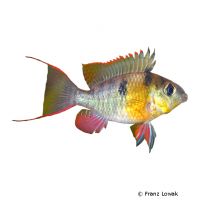Bolivian Ram (Mikrogeophagus altispinosus)
| Bolivian Ram Mikrogeophagus altispinosus | |
|---|---|
| Name | Bolivian Ram |
| Name Lat. | Mikrogeophagus altispinosus |
| Synonym | Papiliochromis altispinosus |
| Family | Cichlids |
| Family lat. | Cichlidae |
| Order | Cichlids |
| Order lat. | Cichliformes |
| Origin | South America |
| Habitat | Rivers, oxbow lakes |
| Diet | Carnivore |
| pH | 6.0-7.5 |
| Behavior | Peaceful |
| Keeping | Pair |
| Care Level | Moderate |
| Reproduction | Substrate spawner |
| Breeding | Moderately difficult |
| Life Span | 3-5 years |
| Protection | No |
| Metric Units | |
| Size | 7-8 cm |
| Temperature | 20-28 °C |
| Hardness | 3-10 °dH |
| Aquarium | 100 l |
| US Units | |
| Size | 2.8"-3.1" |
| Temperature | 68-82 °F |
| Hardness | 53-178 ppm |
| Aquarium | 25 gal |
Distribution and habitat
The distribution area of the Bolivian Butterfly Cichlids is the river system of the upper Rio Madeira in Bolivia and Brazil. They live in slow-flowing and stagnant waters, where they prefer to stay in the shallow riparian zone with muddy-sandy bottoms and dense vegetation.
Maintenance
The aquarium should have a dense border planting, with many hiding places (stones, roots, caves) and provide sufficient swimming space. A dark substrate covered with some foliage (e.g. sea almond leaves), subdued light (floating plants) and soft to medium hard water is ideal.
No ammonia, ammonium or nitrite should be detectable in the water, and the nitrate value should not exceed 100 mg/l. To ensure the water quality and oxygen content, a filter and heater adapted to the aquarium size is required, as well as lighting for the species-appropriate day-night rhythm of the animals.
Diet
In the wild they feed on worms, insect larvae and small crustaceans, which are mainly taken from the bottom. The food supply consists of live food, such as daphnia, cyclops, artemia, mysis, tubifex and red mosquito larvae, which are also accepted without problems in frozen form, or a commercially available, frozen special food mix. Sinking, protein-rich dry food for cichlids (micropellets, granules) is also accepted without problems
Only as much should be fed as is eaten within a few minutes. A regular and varied diet promotes health and increases resistance
Behaviour and compatibility
These peaceful cichlids should be kept in pairs. Pairs form small territories, which they defend at spawning time. Keeping multiple pairs is only recommended in a larger and richly structured tank. They can be socialized well with other small and not too lively fish
Basically, only compatible fish species with similar demands on water quality and water temperature should be socialized.
Sex dimorphism
The slightly larger males are more colorful and have longer extended fins than the females, which appear somewhat rounder.
Reproduction and breeding
They are so-called "open breeders". The eggs are laid on a flat stone, a root or on another substrate (e.g. plant). The female does the brood care, while the male defends the territory. After 2-3 days, the fry hatch and are housed and guarded in a prepared bottom pit until they swim freely after 5-8 days.
Fry must be fed several times a day with special rearing food (Artemia nauplii). In community tanks breeding is hardly possible, because the fry are easy prey.
Important
They show their most beautiful coloration by feeding on live food.
The foliage (sea almond tree, oak, etc.) not only provides cover, but when rotting promotes the development of microorganisms, which are a valuable secondary food source.
The well-being of the fish should be monitored regularly. Temperature should be checked daily, pH, hardness and nitrate levels at least every 14 days. Regular partial water changes are recommended, even when contaminant levels have not yet reached the upper limit. Sudden changes in water quality should be avoided. Newly introduced fish must be accustomed slowly to the water in the aquarium
Further literature can be found in your pet store.
References
Text: petdata; Image: Franz Lowak
Source: BMELV (1998): Tierschutzgutachten - Haltung von Zierfischen (Süßwasser); RIEHL & BAENSCH (2004): Aquarien Atlas Bd. 3, Mergus Verlag; ENGELMANN (2005): Zootierhaltung - Tiere in menschlicher Obhut: Fische, Verlag Harri Deutsch
- Gemäß § 21 Abs. 5 Tierschutzgesetz idgF
